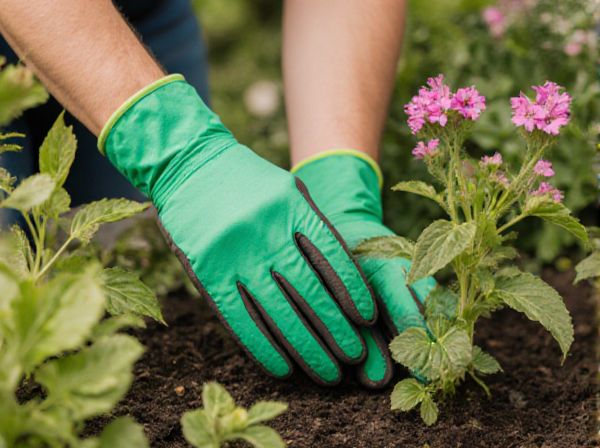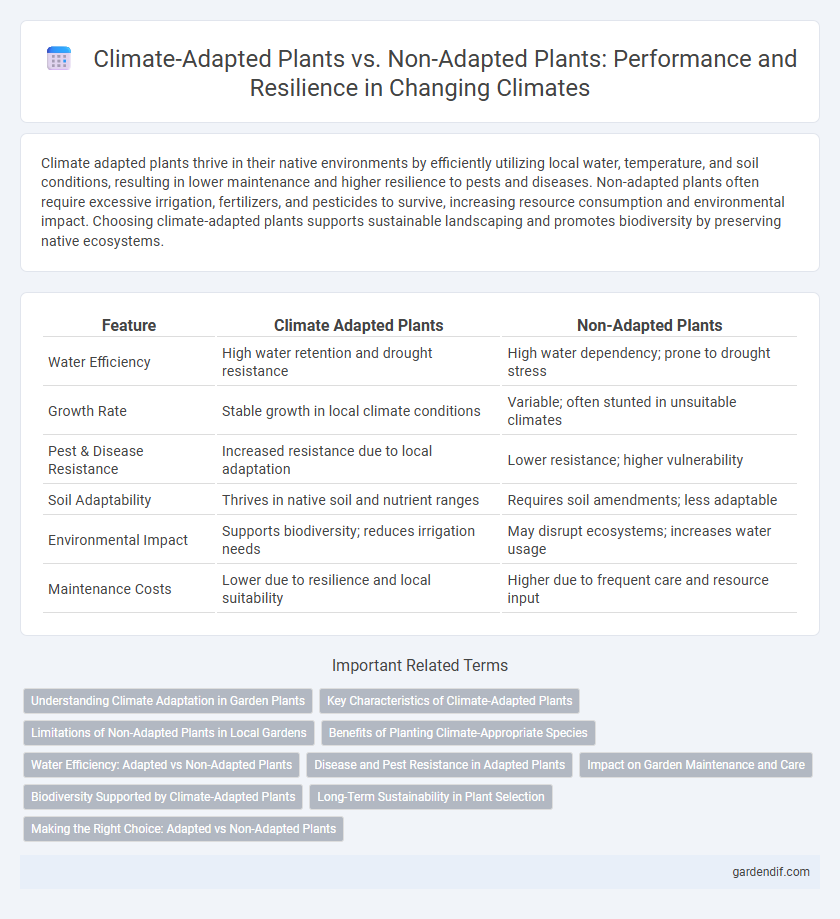
Climate Adapted Plants vs Non-Adapted Plants Illustration
Climate adapted plants thrive in their native environments by efficiently utilizing local water, temperature, and soil conditions, resulting in lower maintenance and higher resilience to pests and diseases. Non-adapted plants often require excessive irrigation, fertilizers, and pesticides to survive, increasing resource consumption and environmental impact. Choosing climate-adapted plants supports sustainable landscaping and promotes biodiversity by preserving native ecosystems.
Table of Comparison
| Feature | Climate Adapted Plants | Non-Adapted Plants |
|---|---|---|
| Water Efficiency | High water retention and drought resistance | High water dependency; prone to drought stress |
| Growth Rate | Stable growth in local climate conditions | Variable; often stunted in unsuitable climates |
| Pest & Disease Resistance | Increased resistance due to local adaptation | Lower resistance; higher vulnerability |
| Soil Adaptability | Thrives in native soil and nutrient ranges | Requires soil amendments; less adaptable |
| Environmental Impact | Supports biodiversity; reduces irrigation needs | May disrupt ecosystems; increases water usage |
| Maintenance Costs | Lower due to resilience and local suitability | Higher due to frequent care and resource input |
Understanding Climate Adaptation in Garden Plants
Climate-adapted plants possess genetic traits that enhance their survival and growth under specific environmental conditions such as temperature extremes, drought, and soil variability. Non-adapted plants often require increased irrigation, fertilizers, and pest control, leading to higher maintenance costs and environmental stress. Understanding climate adaptation in garden plants helps optimize landscape sustainability, conserve water resources, and improve biodiversity resilience against climate change impacts.
Key Characteristics of Climate-Adapted Plants
Climate-adapted plants exhibit drought tolerance, efficient water use, and resistance to temperature extremes, enabling survival in harsh environmental conditions. These plants often have deep root systems, reduced leaf surface area, and waxy or hairy leaves to minimize water loss. Their genetic traits enhance resilience against pests and diseases common in their native climates, promoting sustainable growth without excessive resource input.
Limitations of Non-Adapted Plants in Local Gardens
Non-adapted plants in local gardens often struggle to thrive due to their inability to withstand regional temperature fluctuations, drought conditions, and soil composition. These plants require excessive water, fertilizers, and pesticides, which increases maintenance costs and environmental impact. Failure to adapt can lead to reduced growth, increased susceptibility to pests, and ultimately plant death, undermining garden sustainability.
Benefits of Planting Climate-Appropriate Species
Planting climate-adapted species reduces water consumption by up to 50% compared to non-adapted plants, enhancing sustainability in drought-prone areas. These species improve soil health through deeper root systems, which prevent erosion and increase carbon sequestration. Climate-appropriate plants also support local biodiversity by providing habitat and food sources for native wildlife, strengthening ecosystem resilience against extreme weather events.
Water Efficiency: Adapted vs Non-Adapted Plants
Climate-adapted plants exhibit significantly higher water efficiency than non-adapted plants due to their ability to regulate water use through specialized features such as deeper root systems, reduced leaf surface area, and enhanced stomatal control. These adaptations minimize water loss and optimize uptake, making adapted plants crucial for sustainable landscaping in arid and drought-prone regions. In contrast, non-adapted plants typically require frequent irrigation and are more vulnerable to drought stress, leading to inefficient water use and greater environmental impact.
Disease and Pest Resistance in Adapted Plants
Climate-adapted plants exhibit enhanced resistance to diseases and pests due to their evolved genetic traits that align with local environmental conditions. These plants possess innate defense mechanisms, such as thicker cuticles and increased production of secondary metabolites, which deter pathogens and insect infestations more effectively than non-adapted species. Cultivating climate-adapted plants reduces the reliance on chemical pesticides, promoting sustainable agriculture and ecosystem health.
Impact on Garden Maintenance and Care
Climate-adapted plants require significantly less water, fertilizer, and pest control compared to non-adapted plants, reducing overall garden maintenance efforts and costs. These resilient species thrive in local weather conditions, minimizing the need for frequent pruning, soil amendments, or protection from extreme temperatures. Incorporating climate-adapted plants enhances garden sustainability, promotes biodiversity, and decreases environmental impact through lowered resource consumption.
Biodiversity Supported by Climate-Adapted Plants
Climate-adapted plants enhance biodiversity by providing resilient habitats that support a wide range of native species, including pollinators, insects, and wildlife. These plants require fewer resources such as water and fertilizers, reducing environmental stress and promoting ecosystem stability. In contrast, non-adapted plants often struggle to survive in local conditions, limiting their ability to sustain diverse biological communities and increasing vulnerability to climate change impacts.
Long-Term Sustainability in Plant Selection
Climate-adapted plants exhibit enhanced resilience to local weather patterns and extreme conditions, ensuring long-term sustainability through reduced water usage and lower maintenance requirements. Non-adapted plants often demand excessive irrigation, fertilizers, and pest control, which can deplete natural resources and increase environmental stress over time. Prioritizing native and climate-resilient species supports healthier ecosystems, conserves biodiversity, and promotes sustainable landscaping practices.
Making the Right Choice: Adapted vs Non-Adapted Plants
Climate-adapted plants thrive by requiring less water, fertilizer, and pesticides, resulting in improved sustainability and reduced environmental impact. Non-adapted plants typically demand more intensive care and resources, increasing maintenance costs and vulnerability to local pests and diseases. Selecting climate-adapted species enhances garden resilience, conserves natural resources, and supports local biodiversity in the face of changing weather patterns.
Climate Adapted Plants vs Non-Adapted Plants Infographic

 gardendif.com
gardendif.com